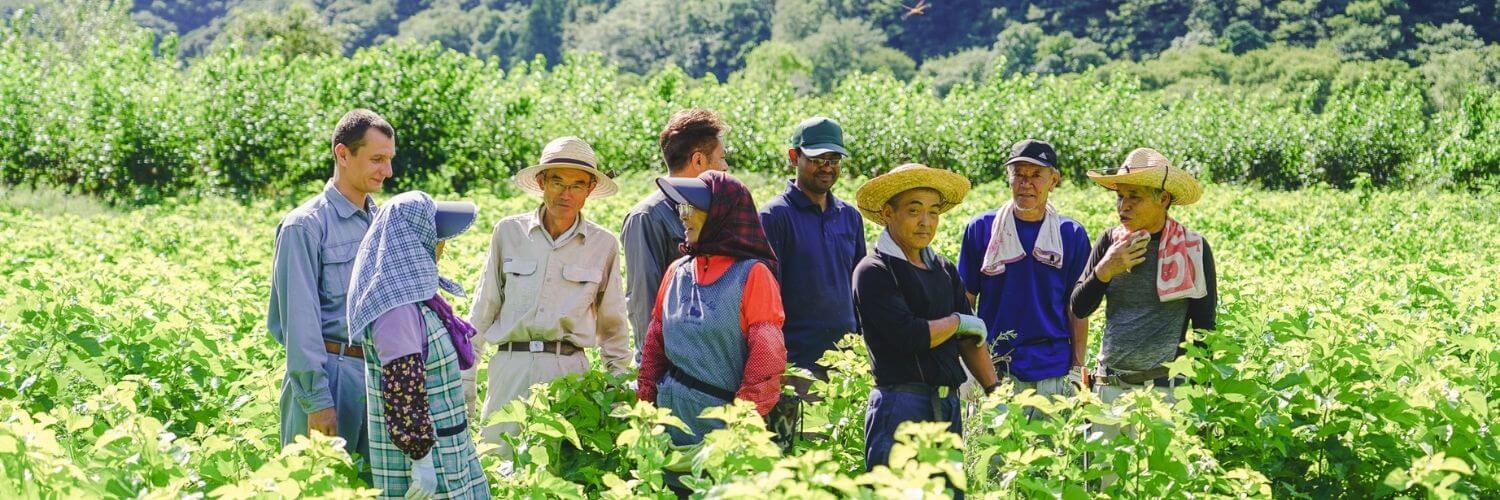
Shimane has many food products unique and special to its culture and history. From green tea to roses, there is something for everybody. To dig deeper into the food history of the area, meet the people maintaining Shimane's identity.
When I’m asked what makes Shimane, “Shimane,” I have a hard time choosing one reason or giving a concise answer. However, having lived in Shimane for two years now, I can say one of the most important takeaways I have is that the people’s character is what makes Shimane the place that it is today. Here, I find individuals who are so passionate about maintaining the history and culture of this area while at the same time creating something new out of it as well. They make it their life’s work to pay homage to their local history and have a social mission of bettering their community. As such, I believe that what makes Shimane so unique are the people and their passion for protecting while building upon their local history, culture, and identity.

In Shimane, there is a lot of hidden history left to be uncovered by people like myself. Before visiting Shimane Organic Farms (a producer of mulberry tea) in Gotsu City, I already had some prior knowledge about the Gonokawa River, which had a habit of flooding. Farming in such an area probably meant that it would be a similar environment to Egypt and the Nile River. The flooding would damage farmland, but it would also bring to the surface all the nutrient-rich soil that would be accumulating in the river.
What I did not know was that during the Edo period, Gotsu City was famous for its mulberry fields, which were initially there for silk production. In the past, Gotsu City was well known for its silk production for kimono making in Kyoto. There were so many mulberry fields in Gotsu that people found it hard to sleep with the sound of the silkworms eating the mulberry leaves. As Furuno-san of Shimane Organic Farms unfolded this hidden history of Gotsu City to me, I was utterly taken in awe by the significance this town played in the past.
In the present, silk production is no longer a local specialty, but Furuno-san continues to grow these mulberry plants for tea and other products. Furuno-san tries to innovate new ways to get the most health benefits out of the mulberry leaves for his customers. He is even going as far as developing special bags to maintain the leaves’ freshness as they are driven to the tea factory. Not only is he creating tea from the leaves, but he is also innovating new products like mulberry matcha. It was inspiring to see the commitment to quality and innovation Furuno-san had towards the mulberry plant. In modern and different ways from the past, Furuno-san keeps the history of the mulberry plants alive in Gotsu while creating a path of its own.


Like the mulberry’s hidden history in Gotsu, I found a long history of rapeseed oil in Izumo when I visited Kageyama-san and Kano-san at Kageyama-Seiyusho. When one hears the name Izumo, I guarantee the first two things that come to mind are the Izumo Taisha Grand Shrine and soba noodles. What I did not know was that rapeseed oil had been documented being used for lighting wicks in some of the earliest writings found in Izumo. Fast-forwarding to today, the rapeseed oil made at Kageyama-Seiyusho is still being used for lighting wicks during special rituals at Izumo Taisha Grand Shrine. However, Kageyama-san and Kano-san were not just satisfied with having a history. They wanted to continue to refine this traditional product to be the “safest & most reliable rapeseed oil for your kitchen.”

First, they ensured that every rapeseed plant grown for their oil was the same species and the best quality. They used tweezers to sort through every batch of seeds they provided for their growers. They also had a bath craftsman to make them their custom roasting tub personally. For filtration, they did not go through not one cycle but three different cycles. The icing on the cake is that all of their oil is of single-origin, and they never blend their oil from other growers. As I listened to all the work that went into one bottle of rapeseed oil, I could not help but respect the resolution to reach the utmost top quality. Kageyama-san and Kano-san were paying homage to their respective products’ history but applying advancements in quality and innovation to make a legacy of their own.




Even with such hidden gems, it is still notoriously known in Japan that Shimane is one of the prefectures people will say, “there is hardly anything there.” To those who continue to doubt Shimane’s endless creative possibility, I would like to introduce Fukuoka-san and Horie-san.
Fukuoka-san of Marufuku Farm is a persimmon expert who grows a species of persimmon called saijyou kaki. Saijyou kaki is considered to have the highest sugar content out of all persimmons after its astringency is taken out through sun-drying processes. Yet, Fukuoka-san’s passion for persimmons does not end at merely growing some of the highest quality persimmons in all of Japan. He is also on a mission to find a hundred different uses for his persimmons.

Fukuoka-san calls this his “Tale of one hundred saijyou kaki,” and just listening to his tale makes you dream of all the possibilities hidden in a single fruit. From freeze-drying persimmons, then pulverizing them and creating a persimmon sugar, fermenting overripe persimmons, and using wine yeast to make persimmon vinegar eventually, Fukuoka-san’s experimentation seems never to end.

On the day I visited him, he kept showing me all his new findings and experiments. Bread baked using his persimmon sugar, persimmon gelato, kaki shibu (fermented green persimmon juice known to have anti-bacterial properties) cough drops, chocolate-covered persimmons. He seemed to have an endless number of projects going. Experiencing the “Tales of one hundred saijyou kaki” in person, I could not help but be in awe of Fukuoka-san’s continuing passion and curiosity towards his persimmons.


On the same theme of transforming one thing into one hundred different things, Horie-san of Yoshida Furusato Mura is another seasoned expert. Yoshida Furusato Mura is a unique company located in Yoshida Village in Unnnan City. They run various infrastructural projects such as public transportation, tourism, product development, local advertisement, and even waterworks maintenance. Horie-san is part of the product development team, where they help create new products to sell using locally grown ingredients. One of their most well-known products is a shichimi togarashi, or seven flavored pepper, using a locally grown pepper called orochi-no-tsume (the claws of orochi).


Yoshida Village is known for this particular red pepper, which is more fragrant, mild, and sweeter than typical red peppers. Translating to “seven flavored pepper blend,” this condiment contains red peppers, yuzu, black sesame seeds, sansho, carrot, burdock, and shungiku. All these ingredients are grown in Yoshida Village, and you can say that you are tasting Yoshida Village in one spice bottle! Yet this is one of the many products that Horie-san has produced in the village.
As Horie-san explained to me, they even make small-batch products such as their salad dressing using local carrots. Companies usually tend only to make products in large batches to increase profits as much as possible. Yet with Yoshida Furusato Mura’s goal being the sustainability of their village, they gladly support any forward-thinking action by its residents. Yoshida Village may be one small town for some, but for people like Horie-san, one village contains one hundred different possibilities!
Out of one fruit or from one village, Shimane’s people can continue looking deeper, finding new and fascinated ways to captivate those involved. Rather than stretching themselves thin for the sake of variety, they all have an unbudging commitment to some mission that becomes the axis to their worldliness.

As I was exploring how the people of Shimane were sustaining their history and culture, I was curious to see how something entirely new is being built here as well. This led me to coincidentally visit two different companies that were growing flowers to create new local specialties.
The first place I visited was Fukuma-san at Oku-Izumo Rose Garden. Although their name is Oku-Izumo, a further town north-east from Omori, I was surprised to learn that they were located in Oda-city, the same city my town of Omori is located. As I drove towards the company, I realized that there were rose gardens hidden among them within the familiar sights of Oda-City! It was a new sight to see rice paddies next to a rose garden.


When talking to Fukuma-san, I had to ask the reason why he is growing roses in Shimane. Surely, there were more common agricultural products that were more major in Shimane that they could have produced. To my question, Fukuma-san gave me a simple answer “we are trying to make something new, some new culture here.” Starting with his father, Fukuma-san tried to create a new product and break the established image of what the inaka, or the countryside, is through their roses.
Of course, it is essential to maintain tradition, but at the same time, it was as important to create something new, something unexpected. That is what Fukuma-san was doing with his brand concept of “roses that you can eat,” and it was working. Personally, the products they were making were unique and intriguing, but it helped the local economy as well. Fukuma-san had his rose products made in a factory in Oda city, where the people there seemed so grateful for doing business with him. By the end of my visit, I could see how Fukuma-san was creating a brand-new image for the Japanese countryside through one rose at a time.


I had a similar experience when I headed to Oku-Izumo to see how an edible dry flower company called Tom was creating a new local specialty. Hearing “new local specialty,” I expected a highly industrialized process of making dried edible flowers. Yet when I arrived, I was pleasantly surprised that it was more forward-thinking and revitalizing for the local area.




Yasawa-san, the president of Tom, showed me how they used these small and easy-to-use contraptions to make oshibana or dried flowers essentially. The reason being, they were having the local elderly residents make these dried flowers at their homes. As Yasawa-san explained to me, many of these older residents were looking for something to do after retirement. Simultaneously, many of them (mostly females) were already in local flower growing groups and had the skill set to grow and dry these edible flowers themselves. By working together with the local elders, Yasawa-san was creating a business that fulfilled the needs of the elderly and the local economy.


While Yasawa-san hopes to continue having these local elders make these dried flowers, he also hopes that young people find his business a reason to return to Oku-Izumo. In this way, Yasawa-san’s dry edible flowers have a mission to re-connect different generations together for his hometown’s future.

What makes Shimane so special is by far the people here and their dedication to authenticity with a creative twist. From mulberry leaves to dry flowers, each has a story and a reason connecting to Shimane. It amazes me when I see these people who continue to bring out so much possibility from the land and utilize it for not only themselves but also for the local community. I would go as far as to say that these people are the backbones of this prefecture, making Shimane an exceptional place. Getting the opportunity to meet and learn about the people I visited this time has deepened my understanding and appreciation for their work and Shimane as well. Not only that, it has gotten me excited to see what other projects they will start soon as well!
